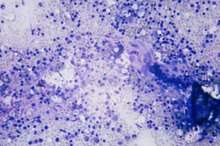List of Painful Terminal Diseases
Many terminal diseases can cause pain. According to the U.S. National Library of Medicine and the National Institutes of Health, or NIH, a person with a terminal illness can decide to pursue aggressive treatment or stop treatment all together 1. Pursuing aggressive treatments for terminal illness may prolong a person's life, but stopping treatment could mean that the individual experiences a more comfortable death. Pain management techniques in the later stages of a terminal illness may provide a person with temporary relief.
If you are experiencing serious medical symptoms, seek emergency treatment immediately.
Pancreatic Cancer
Pancreatic cancer is a painful terminal disease. According to the Hirshberg Foundation for Pancreatic Cancer Research, or HFPCR, an organization dedicated to finding a cure for pancreatic cancer, the pancreas is an organ situated in the upper abdomen, behind the stomach. The pancreas lies in proximity to the small intestine, liver and spleen. The HFPCR states that pancreatic cancer develops due to the uncontrolled growth of abnormal cells in the pancreas. Although the exact cause:
- of pancreas cancer is unknown
- numerous factors may contribute to its development
- including age
- gender
- race
- smoking history
- diet
- diabetes
- environmental factors
- heredity
According to the National Cancer Institute--a division of the NIH--pancreatic cancer may cause few symptoms early on. However, as the disease progresses, a person may experience significant pain in the upper part of her abdomen and back.
- Pancreatic cancer is a painful terminal disease.
- According to the Hirshberg Foundation for Pancreatic Cancer Research, or HFPCR, an organization dedicated to finding a cure for pancreatic cancer, the pancreas is an organ situated in the upper abdomen, behind the stomach.
Ebola Hemorrhagic Fever
Causes of Temporary Leg Paralysis
Learn More
Ebola hemorrhagic fever is a painful terminal disease. The World Health Organization, or WHO, states that Ebola hemorrhagic fever is a viral hemorrhagic fever and one of the most virulent diseases experienced by humans. A small percentage of individuals affected by Ebola hemorrhagic fever do survive, but the vast majority of people who contract this disease succumb within three weeks of its onset. There is no standard treatment for Ebola hemorrhagic fever. The Centers for Disease Control and Prevention, or CDC, states that Ebola hemorrhagic fever can be transmitted by direct contact with the blood or secretions of an infected person or by direct contact with objects that have been exposed to another person's infected secretions.
- Ebola hemorrhagic fever is a painful terminal disease.
- The Centers for Disease Control and Prevention, or CDC, states that Ebola hemorrhagic fever can be transmitted by direct contact with the blood or secretions of an infected person or by direct contact with objects that have been exposed to another person's infected secretions.
Lesch-Nyhan Syndrome
Lesch-Nyhan syndrome is a painful terminal disease. According to the National Institute of Neurological Disorders and Stroke, or NINDS, a division of the NIH, Lesch-Nyhan syndrome is a genetic disorder caused by a deficiency of the enzyme hypoxanthine-guanine phosphoribosyltransferase, or HPRT.cause:
- According to the National Institute of Neurological Disorders
- Stroke
- or NINDS
- a division of the NIH
- Lesch-Nyhan syndrome is a genetic disorder caused by a deficiency of the enzyme hypoxanthine-guanine phosphoribosyltransferase
- or HPRT
The NINDS states that, without sufficient HPRT, uric acid accumulates in the body fluids of a person with Lesch-Nyhan syndrome. Uric acid accumulation causes severe gout, lack of muscle control and moderate retardation. These symptoms typically appear in the first year of life. Elevated uric acid levels cause sodium urate crystals to manifest in a person's joints, kidneys and central nervous system, which causes significant swelling in the joints and serious kidney problems. According to the NINDS, Lesch-Nyhan syndrome is also characterized by self-mutilating behaviors that develop in the second year of life. Most people with Lesch-Nyhan syndrome die from kidney failure within the first or second decade of life.
- Lesch-Nyhan syndrome is a painful terminal disease.
- According to the NINDS, Lesch-Nyhan syndrome is also characterized by self-mutilating behaviors that develop in the second year of life.
Related Articles
References
- National Institutes of Health: End of Life Issues
- National Institutes of Health Genetics Home Reference. Lesch-Nyhan syndrome. Updated 2019.
- National Organization for Rare Disorders. Lesch Nyhan syndrome. Updated 2020.
- NORD (National Organization for Rare Disorders). International Center for Disability Resources on the Internet. Updated 2020.
Writer Bio
Martin Hughes is a chiropractic physician, health writer and the co-owner of a website devoted to natural footgear. He writes about health, fitness, diet and lifestyle. Hughes earned his Bachelor of Science in kinesiology at the University of Waterloo and his doctoral degree from Western States Chiropractic College in Portland, Ore.









